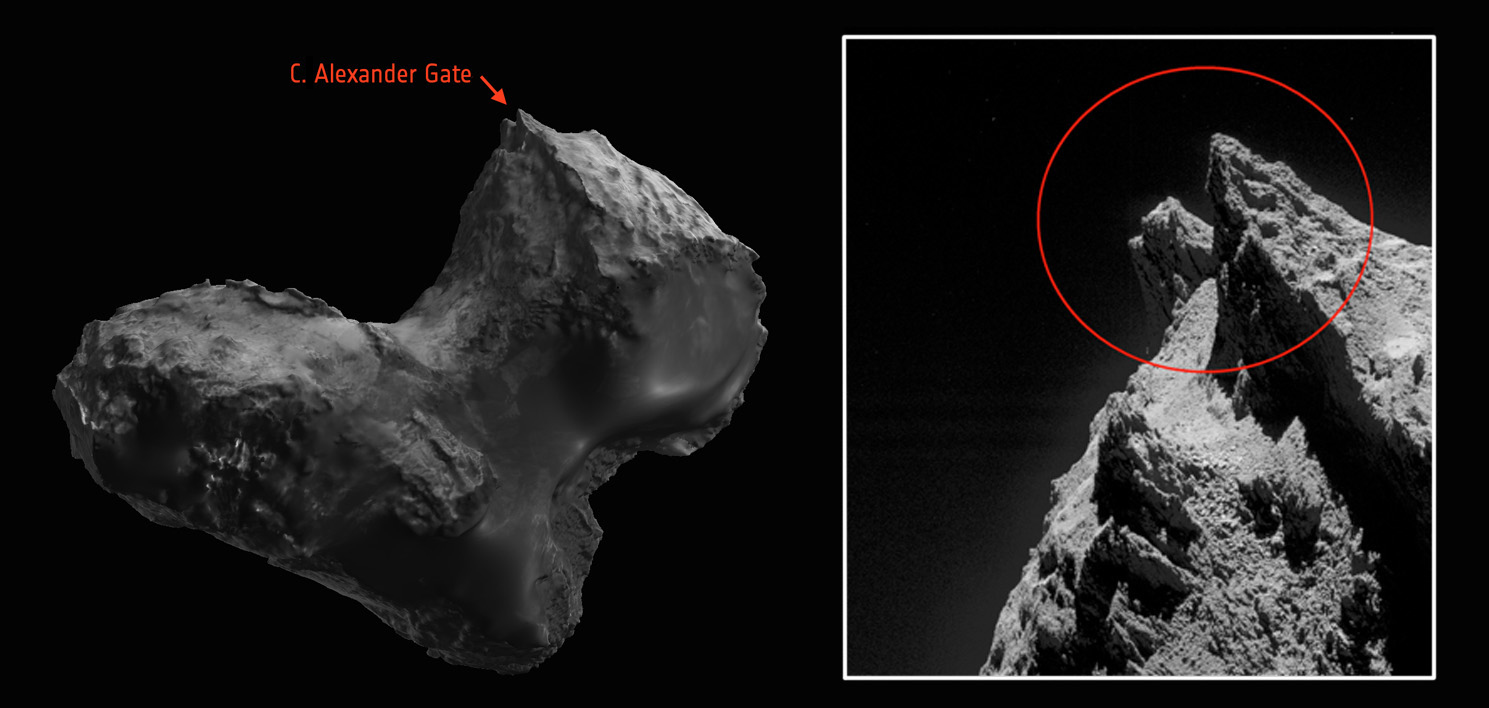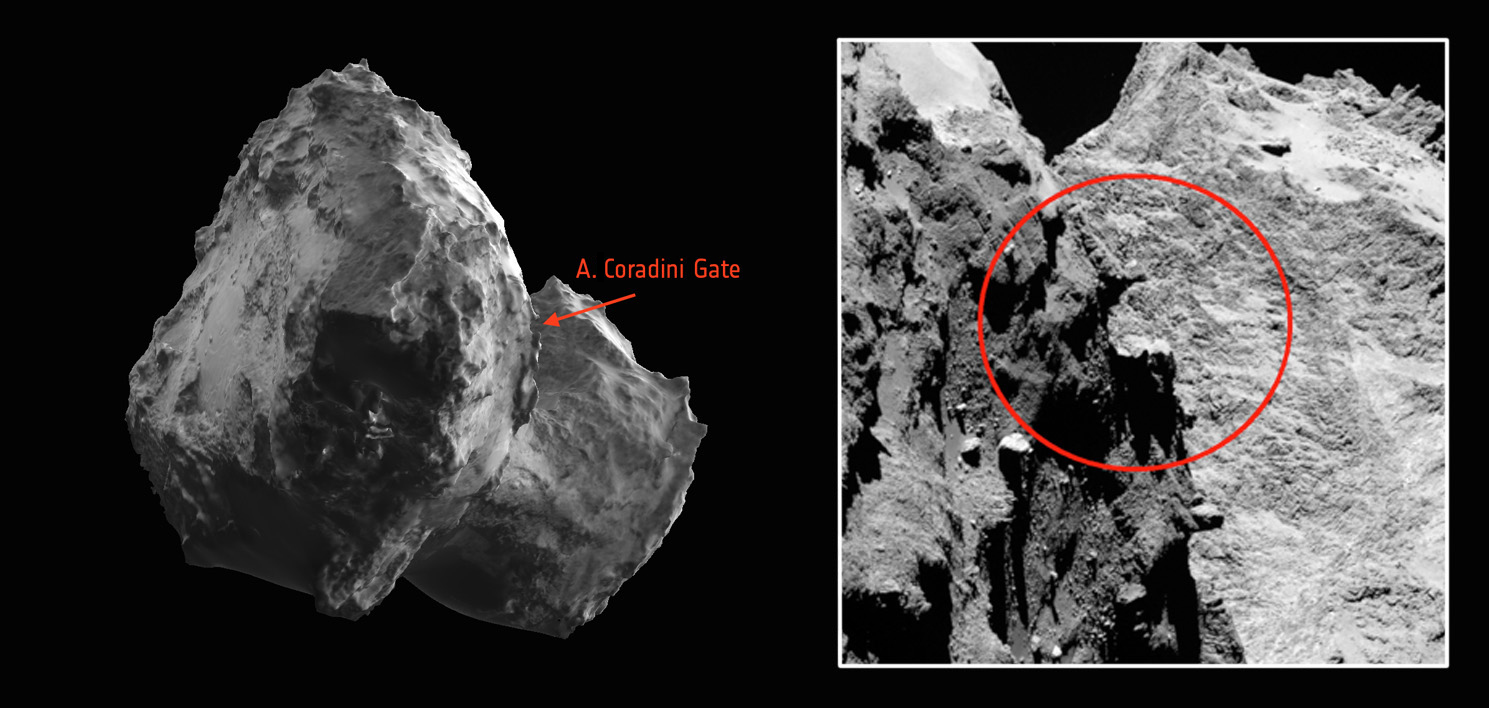Rosetta Team Names Comet Features for Lost Colleagues

Two prominent features on Comet 67P/Churyumov-Gerasimenko were selected by the European Space Agency's Rosetta team to be dedicated to two mission colleagues, respectively, who recently passed away.
Rosetta project scientist Matt Taylor, of the European Space Agency, wrote in a blog post that because the Rosetta project "has been going on for almost 30 years, it is also regrettably inevitable that a few members of this large team have been outlived by the mission."
"These two features were chosen for their prominence on Comet 67P/C-G, and for their very distinctive and striking gatelike appearances, considered to be highly appropriate monuments for our absent colleagues," Taylor wrote. [5 Amazing Facts about Europe's Comet-Chasing Rosetta Probe]
The C. Alexander Gate
The C. Alexander Gate, located on the smaller lobe of Comet 67P/C-G, has been named for Claudia J. Alexander, a U.S. Rosetta project scientist. Alexander passed away on July 11, 2015, after a 10-year battle with breast cancer. She was 56.
Alexander earned a bachelor's degree in geophysics from the University of California, Berkeley, and a master's degree in geophysics and space physics from the University of California, Los Angeles. She went on to earn her doctorate degree in atmospheric, oceanic and space sciences from the University of Michigan, Ann Arbor. She began working at NASA's Jet Propulsion Laboratory in California before completing her doctorate. At the relatively young age of 40, she served as project manager for NASA's Galileo mission in 2000.
Alexander strove to inspire young people, writing children's books on science and mentoring young African-American girls. She also wrote "steampunk" science-fiction short stories.
"Science and math are fascinating and fundamental. They require as much discipline to study and master as an athlete working to be a football player, or a musician attempting to land a recording contract," Alexander said in an interview with NASA.
Breaking space news, the latest updates on rocket launches, skywatching events and more!
"But the rewards are just as terrific! Imagine being the first person to make a discovery, to have a mathematical principle named after you or to make the fundamental discoveries that take civilization to the next level?
"In the annals of history, the athletes and musicians fade, but the ones who make fundamental improvements in humankind's way of life, and in their understanding of the universe, live on in their discoveries."
The A. Coradini Gate
The A. Coradini Gate, located on the larger lobe of the comet, was dedicated to Angioletta Coradini, the former principal investigator of Rosetta's VIRTIS instrument. Coradini passed away in September 2011 after a year-long battle with cancer. She was 65.
Coradini earned her master's degree in physics at the University of Rome, where she also earned her doctorate degree. She worked for the National Research Council of Italy before moving on to the National Astrophysics Institute of Italy. She led the Italian team for the Cassini VIMS visual channel. She worked on NASA's Dawn mission team, which explored the asteroid Vesta and is presently in orbit around the dwarf planet Ceres.
"Angioletta was one of the world-recognized leading experts in the Planetary Sciences, with varied interests ranging from minor bodies to outer planets and theoretical work on the formation of our solar system," said a tribute posted on the American Astronomical Society website. "She made fundamental contributions in all these domains."
In 2014, a crater on the asteroid Vesta was named Angioletta, after the scientist, breaking the original convention of naming the craters for female personalities of the ancient Roman world.
"Angioletta Coradini [was] one of the most important researchers in planetology worldwide," Maria Cristina De Sanctis, team leader of Dawn's VIR instrument, said in a 2014 article by Italy's National Institute of Astrophysics.
Follow Nola Taylor Redd on Twitter @NolaTRedd or Google+. Follow us @Spacedotcom, Facebook or Google+. Originally published on Space.com.

Nola Taylor Tillman is a contributing writer for Space.com. She loves all things space and astronomy-related, and always wants to learn more. She has a Bachelor's degree in English and Astrophysics from Agnes Scott College and served as an intern at Sky & Telescope magazine. She loves to speak to groups on astronomy-related subjects. She lives with her husband in Atlanta, Georgia. Follow her on Bluesky at @astrowriter.social.bluesky



